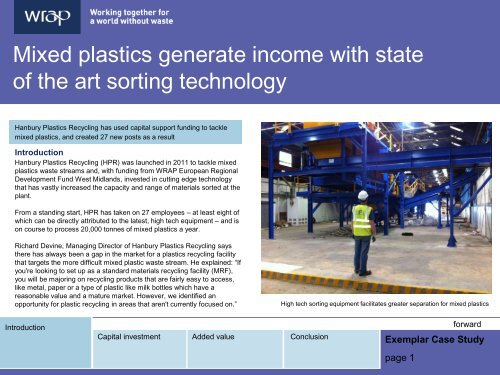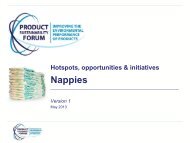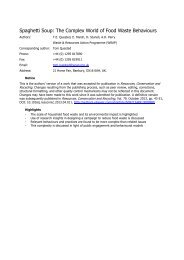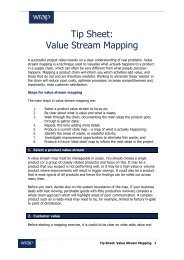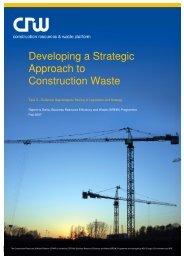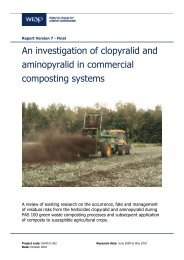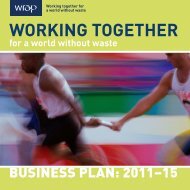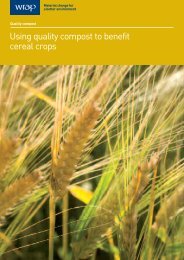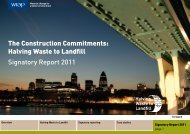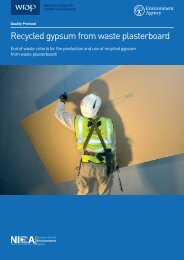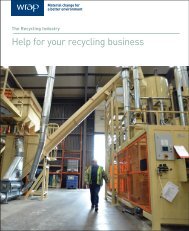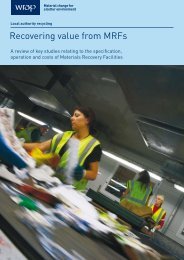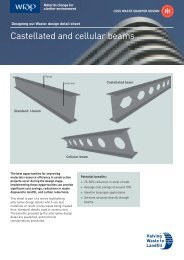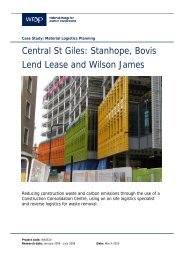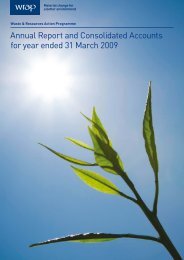Hanbury Plastics Recycling case study - Wrap
Hanbury Plastics Recycling case study - Wrap
Hanbury Plastics Recycling case study - Wrap
- No tags were found...
Create successful ePaper yourself
Turn your PDF publications into a flip-book with our unique Google optimized e-Paper software.
Mixed plastics generate income with stateof the art sorting technology<strong>Hanbury</strong> <strong>Plastics</strong> <strong>Recycling</strong> has used capital support funding to tacklemixed plastics, and created 27 new posts as a resultIntroduction<strong>Hanbury</strong> <strong>Plastics</strong> <strong>Recycling</strong> (HPR) was launched in 2011 to tackle mixedplastics waste streams and, with funding from WRAP European RegionalDevelopment Fund West Midlands, invested in cutting edge technologythat has vastly increased the capacity and range of materials sorted at theplant.From a standing start, HPR has taken on 27 employees – at least eight ofwhich can be directly attributed to the latest, high tech equipment – and ison course to process 20,000 tonnes of mixed plastics a year.Richard Devine, Managing Director of <strong>Hanbury</strong> <strong>Plastics</strong> <strong>Recycling</strong> saysthere has always been a gap in the market for a plastics recycling facilitythat targets the more difficult mixed plastic waste stream. He explained: “Ifyou're looking to set up as a standard materials recycling facility (MRF),you will be majoring on recycling products that are fairly easy to access,like metal, paper or a type of plastic like milk bottles which have areasonable value and a mature market. However, we identified anopportunity for plastic recycling in areas that aren't currently focused on.”High tech sorting equipment facilitates greater separation for mixed plasticsIntroductionCapital investmentAdded valueConclusionforwardExemplar Case Studypage 1
<strong>Hanbury</strong> <strong>Plastics</strong> <strong>Recycling</strong>Capital investmentDavid Rogers, Project Manager for the WRAP European RegionalDevelopment Fund West Midlands programme agreed: “The West Midlandshad a severe lack of mixed plastic recycling provision, meaning that mostwaste companies were forced to landfill their mixed plastic waste. Thisfacility not only diverts that waste from landfill, but also presents an excellentopportunity to develop higher value markets for recycled plastic, creatingwealth for the region and saving businesses money.”HPR applied for two grants through the programme. The first enabled thebusiness to opt for automatic sorting rather than using manual systems,while the second facilitated a significant increase in capacity through theinstallation of additional equipment.Devine clarified: “One of the grants was for small capital purchases; we werelooking to spend around £350,000 on near infra-red sorters and WRAPERDF contributed £100,000. Following that investment, the business wassteamrollering along, and an application was put to the large capital scheme.Under that, we were awarded another £340,000, based on a spend of£850,000 to increase capacity. In total we've spent around £2.5 million, witha contribution of £440,000 of ERDF capital funding through WRAP.”The company was convinced that although manual sorting requires aninitially lower capital investment, automatic sorting offered the most costeffective and efficient option in the long term. It also looked at lease and hirepurchase options, but found these untenable. Devine added that the grantwas especially welcome and helped to demonstrate to suppliers that HPRwas a reliable firm.Sorting plastics by polymer type adds valueCapital investmentback : forwardAdded valueIntroduction ConclusionExemplar Case Studypage 2
<strong>Hanbury</strong> <strong>Plastics</strong> <strong>Recycling</strong>Added valueOnce finance was in place, HPR bought converting equipment for movingitems from one part of the plant to another; mechanical separationequipment; ballistic separation machinery; colour and near infra-reddetection equipment; and automatic sorting devices. With thisinfrastructure, it is able to sort seven streams of polymer – film, clear andcoloured HDPE, clear and coloured PET, coloured polypropylene, andpolystyrene.Devine says that the plant is producing polymer purity rates of 97 percent. This means that it can supply buyers with virtually pure stock ofeach of the seven available types. Similarly, buyers are able to requestspecific colours. He explained: “For example, one of our processorswants to use polypropylene in an injection moulding that is predominantlygreen. We are able to provide them with material in blues, greens andyellows to make up the correct colour.”Sorted polymers are mainly sold to UK processors and used in a widerange of markets and processes, from injection mouldings andautomotive markets to textiles and loft insulation. However, mixed plasticsare still widely viewed as problematic, and few companies are equippedto sort them into sufficiently unique polymers, which adds value andmakes them available for manufacturing processes. As a result, largenumbers of useful polymers are consigned to landfill each year.The HPR site is on target to divert 20,000 tonnes of plastics from landfilleach year and aims to process double this amount when additional nearinfra-red sorters have been added and the plant is fully operational.Feedstock is typically sourced from MRFs. Devine explained: “Weconcentrate on pre-sorted, post-consumer packaging materials. We arethe next step after a MRF operator has taken comingled waste andremoved the dry recyclables, or we take material from other plasticprocessors who may be looking for one particular type of plastic and havean out-throw from mixed material that they take in.“We also go a step further than many others: if someonecame to us with material that appeared to have a lot ofplastic in it, but also had a large percentage of contamination– paper or textiles – most plastic processors would say it wastoo difficult to separate. What we do is take material that theindustry defines as rubbish, refine the sorting, and take up to12 different fractions out of that comingled out-throw.”Managing Director, Richard DevineEmploymentFrom design of the plant to production took just five months. Once up andrunning, HPR was able to identify a number of improvements to thesystem, such as the addition of automated systems to load from thebunkers where sorted material awaits baling. Future plans also includethe addition of a second line and, potentially, the development ofprocessing techniques such as extrusion, which will bring added value tothe more minor plastic ranges.Added valueback : forwardIntroduction Capital investmentConclusionExemplar Case Studypage 3
<strong>Hanbury</strong> <strong>Plastics</strong> <strong>Recycling</strong>ConclusionIndustry in Stoke on Trent, where the company is based, has been hit hardover the last decade, with traditional businesses like ceramics and heavyindustry in decline. The advent of a growing employer is welcome,especially where the jobs created are for skilled workers. Devine said thecompany has taken on a range of skill levels, from manual workers to thosequalified to operate forklifts and counterbalances, and supervisorsresponsible for setting and maintaining optical sorters.He is clear that the funding has brought a wide range of benefits, to thecompany, wider economy, and to the environment. He concluded: “Theprocess of applying for the grant was, in itself, a very good discipline for anew company; the people who look at awarding these grants are seasonedprofessionals and know what it takes to make a successful business, sofrom our point of view, getting approval was an acknowledgement that weknew what we were doing.“On a wider level, this is a relatively small island, with 65 million peopleliving here. If we don't do anything at all, we will generate 1.7 million tonnesof waste plastic packaging every single year straight to landfill. In trying toreprocess and recycle it, and get it into a re-use situation, we are avoidinglandfill costs, creating jobs, and we're at the forefront of a new industrywhich is all about recycling products.”<strong>Hanbury</strong> <strong>Plastics</strong> <strong>Recycling</strong>’s new equipment has not only divertedadditional material from landfill but also created valuable jobsIntroductionCapital investmentAdded valueConclusionback : forwardExemplar Case Studypage 4
This <strong>case</strong> <strong>study</strong> is one of a series that examines how businesses have benefited from funding through theWRAP European Regional Development Fund West MidlandsWhile steps have been taken to ensure its accuracy, WRAP cannot accept responsibility or be held liable to any personfor any loss or damage arising out of or in connection with this information being inaccurate, incomplete or misleading.This material is copyrighted. It may be reproduced free of charge subject to the material being accurate and not usedin a misleading context. The source of the material must be identified and the copyright status acknowledged. Thismaterial must not be used to endorse or used to suggest WRAP’s endorsement of a commercial product or service.For more detail, please refer to our Terms & Conditions on our website - www.wrap.org.ukback : homeWaste & ResourcesAction ProgrammeThe Old Academy21 Horse FairBanbury, Oxon OX16 OAHTel: 01295 819 900Fax: 01295 819 911E-mail info@wrap.org.ukHelpline freephone0808 100 2040www.wrap.org.uk


